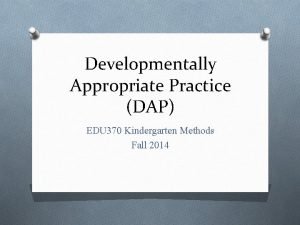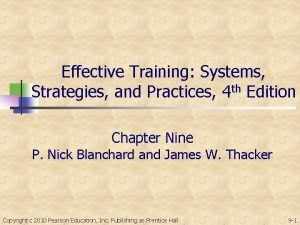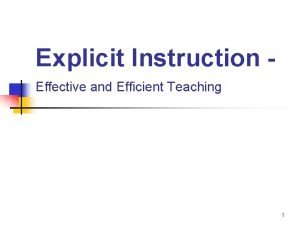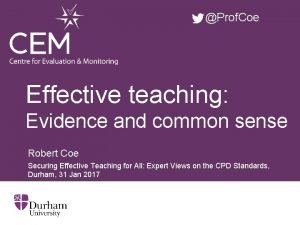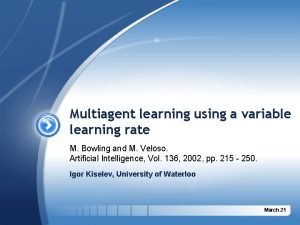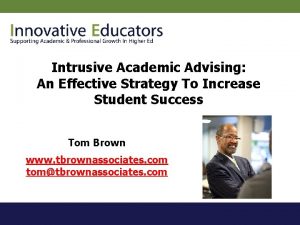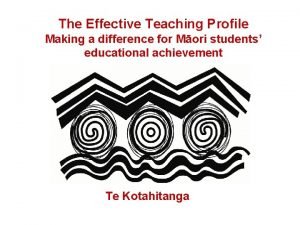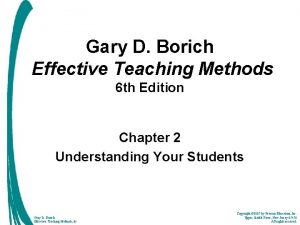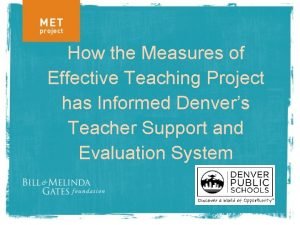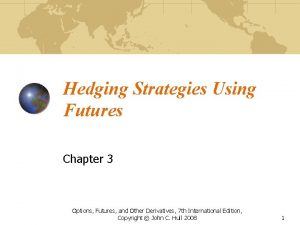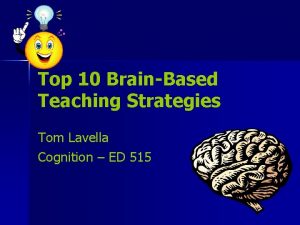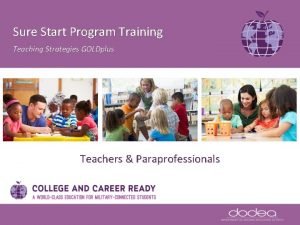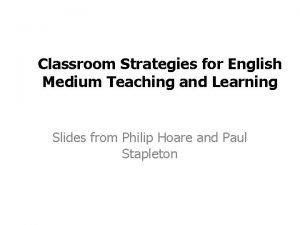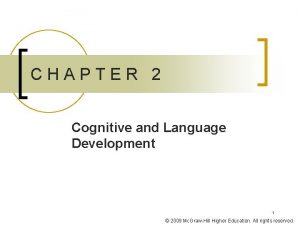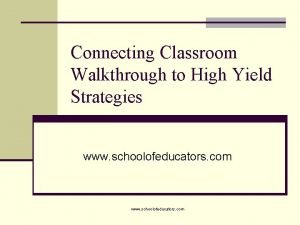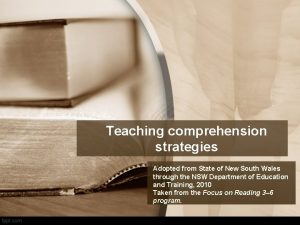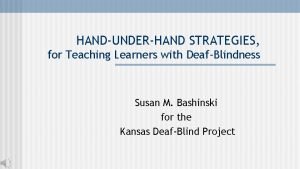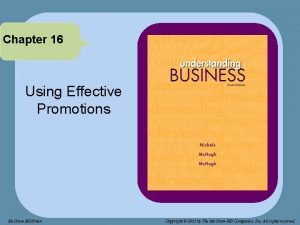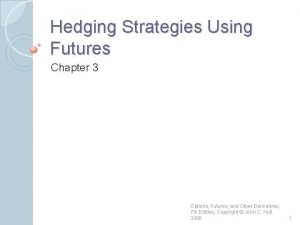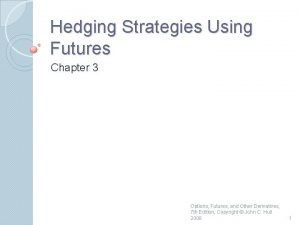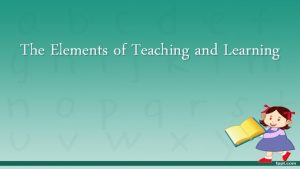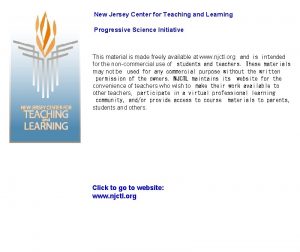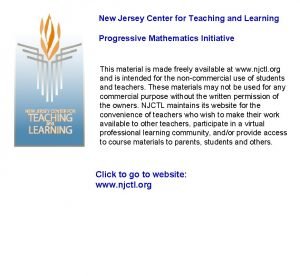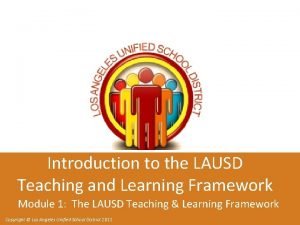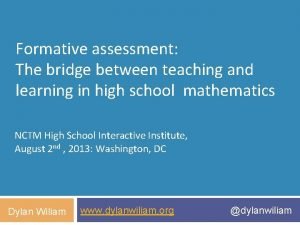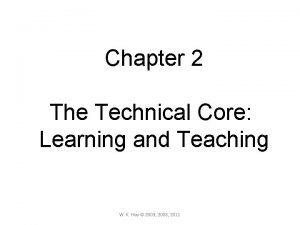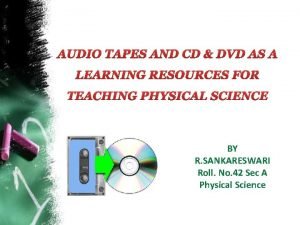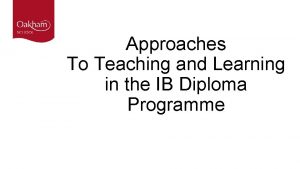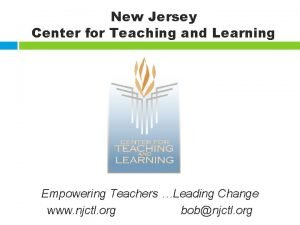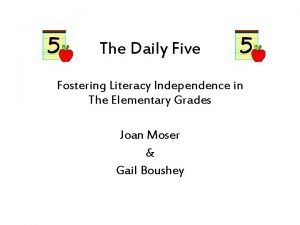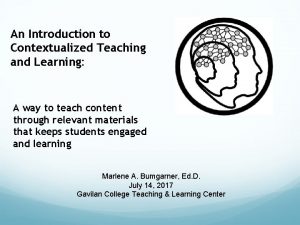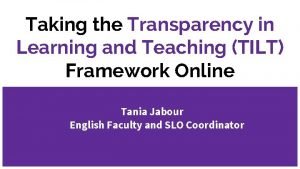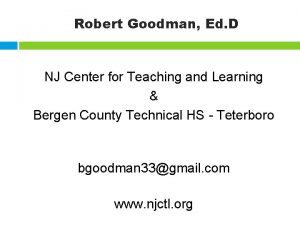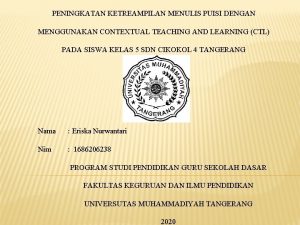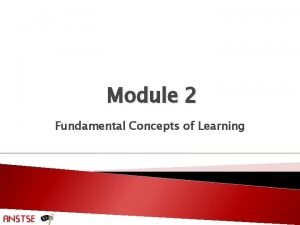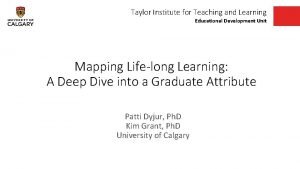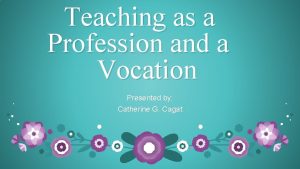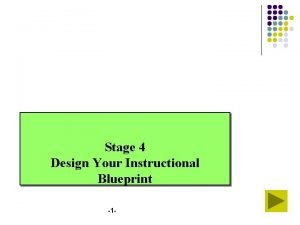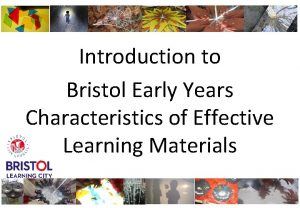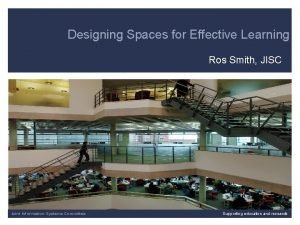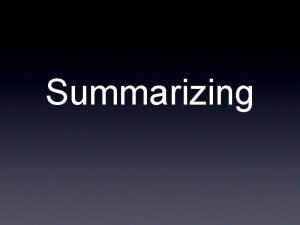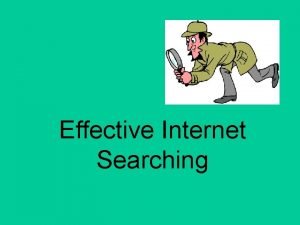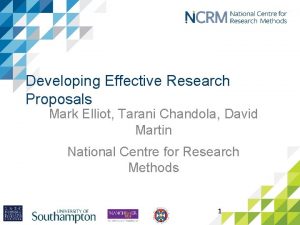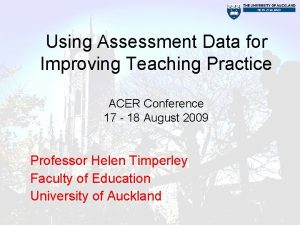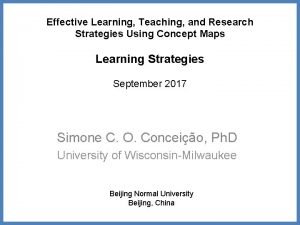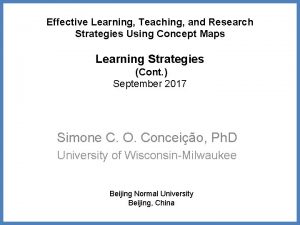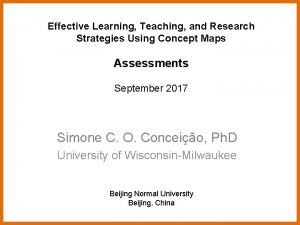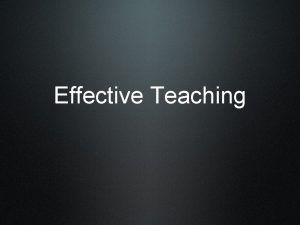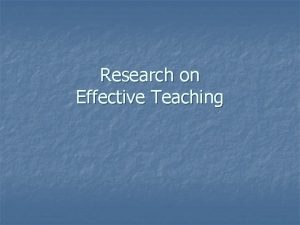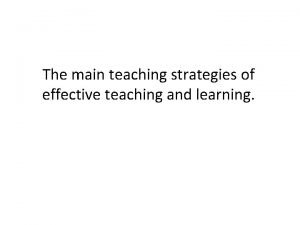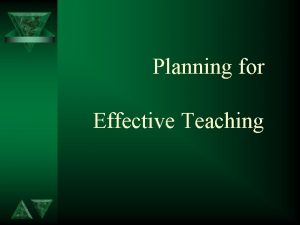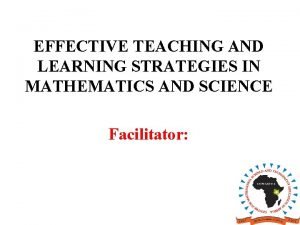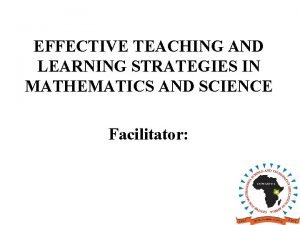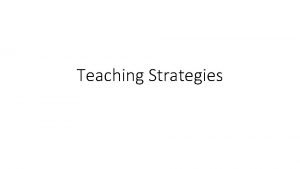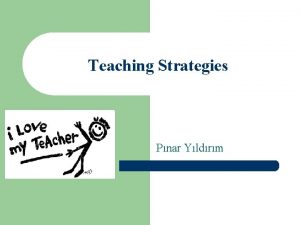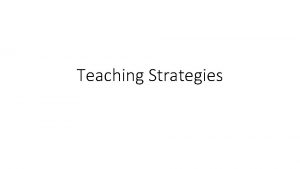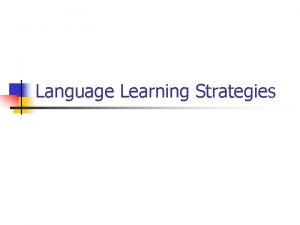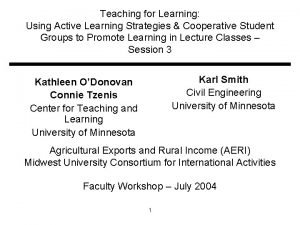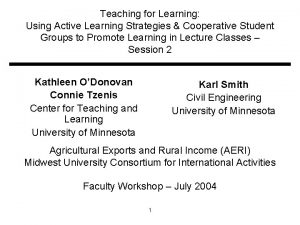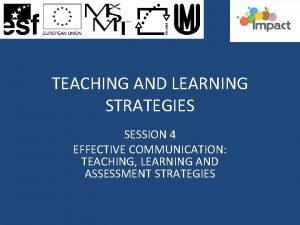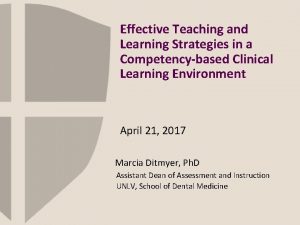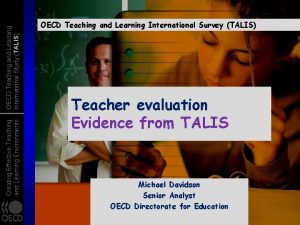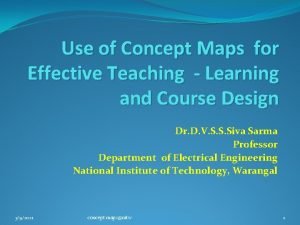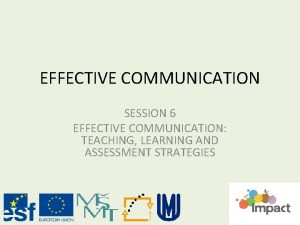Effective Learning Teaching and Research Strategies Using Concept




















































- Slides: 52

Effective Learning, Teaching, and Research Strategies Using Concept Maps Learning Strategies May 2018 Simone C. O. Conceição, Ph. D University of Wisconsin-Milwaukee Beijing Normal University Beijing, China

Remember to Use Your Name Tag

Outline Icebreaker Needs Assessment Results Becoming a Critically Reflective Learner/Teacher What is a Learning Strategy? Studies Showing Use of Concept Maps in Different Disciplines • Undergraduate Education • Graduate Education • Economics Education • Science Education • Nursing Education Debriefing

NEEDS ASSESSMENT RESULTS

Majors Educational Policy and Law Education Management Marxism Theory Neuroscience Philosophy Psychology: Sexuality Education Teacher education (2) Vocational Education and Training

Group Characteristics

Group Characteristics Wants to learn more about the would and its secret Open-minded, interested in education and sociology Has enthusiasm for education, full of curiosity, eager to learn more things and new knowledge Wants to improve self and works with someone who is more experienced than her/him

Group Characteristics Speaks her mind, likes different viewpoints, has lots of ideas if interested in something, shares them even if ideas are rejected. Wants to share thoughts in class Good learner, prefers to see the end of what is been done. Is happy to learn something new and interesting Lazy but kind, introverted

A listener As a reader, you are/have/want… A wide-ranged of interests, reads with questions An epic classic story fancier and dedicated story teller To read passages with headlines and prefers short ones I don’t like reading highly, abstract works To think more about what is read, which kind of slows down while reading Poor English learner Slow reader To find something engaging, I think about it a lot after. Usually reads enjoyable parts multiple times and keeps pondering about it.

I think about group work… Interesting, also we can know more about each other and share our ideas A great chance to cooperate with others, and a great opportunity to communicate with partners A little bit hard for me, but I think is an effective way to learn and to negotiate with others Interesting, but also can be a challenge Little challenging for me. But I always try to be open and work with others Happy Not easy, sometimes necessary. It also requires some techniques Prefer to take the lead. I think too many people working together is ineffective, so I prefer fewer people or pairs. A good way to learn

Preference for Assignment Directions Try to understand it and do it The direction and the requirements can be posted on Wechat group Tasks based on theoretical structures and flexible about making own decisions To explore it first by myself and then if any problem, I will turn to my instructor for help Think about it in my own way, to be more precise, I want to understand it and show my personal skills in the assignment Clear (well expressed) Understand it then make a note I prefer to start the assignment straightaway, if any questions arise while doing it, I will ask the instructor again Do it by myself

Learning Philosophy Continuing to find something new Disagreeing Finding the truth Anytime, anywhere Connecting own experience with facts Associating with others Building personal mental representation Learning by doing different ways To be or not to be

ICEBREAKER

Critical Incident Technique: Understanding Our Autobiography • Think back over your recent learning experiences. • Choose an incident that made you say to yourself, “This is what makes learning so difficult, ” or that made you think about not being a student any more. • Write some notes about the incident. Include – – Where this event happened When this event happened Who was involved What it was that made the event so significant for you

Critical Incident Technique: Understanding Our Autobiography • Now, think back and choose an incident that made you say to yourself, “This is what learning is really all about” or “This was a great experience for me as a student. ” • Write some notes about that incident. – – Where it happened When the event happened Who was involved Why it was significant to you

(Brookfield, 1995)

Becoming a Reflective Learner/Teacher Autobiography • Helps us see ourselves, puts us in the role of the learner, personal self-reflection Classmates / Colleagues • Fosters seeing learning and teaching in a new light, new ideas, see aspects of our learning and practice that may be hidden (Brookfield, 1995)

Becoming a Reflective Learner/Teacher Theory • Helps understand experience by naming it in different ways Helping Our Teachers, Learning From Our Students • Helping teachers by evaluating how we are doing. • Seeing self as our students make us aware of actions that confirm or challenge power relationships in the classroom (Brookfield, 1995)

Understanding our Autobiography with Our Classmates / Colleagues Similarities • in events • in significance Differences • in events • in significance

Understanding Learning Theories (Merriam, Caffarella, & Baumgartner, 2006) Behaviorism Constructivist Social Learning Cognitivist Humanist

Behaviorism Operant conditioning • Behavior followed by a consequence likely to occur again Reinforcer a consequence having the desired effect • Negative reinforcers things the organism turns away from Struggle for freedom is to expect certain behavioral consequences • Discussion should be about what types of control we are exposed to

Behaviorist Perspective Learning Process Change behavior Locus of Learning Stimuli in environment Teacher’s Role Arranges environment to get response Manifestations in Learning n Behavioral objectives n Competency-based education n Skill development and training

Behaviorist Strategies Needs Assessment Design for Learning • Learning needs, Learning wants, Gap analysis, System analysis, Tests • Program focus, Program setting, Instructional goals, Instructional resources Program Objectives • Description, Conditions, Criterion Learning Activities

Behaviorist Strategies How can behaviorist strategies be used with concept maps?


Cognitivist Theory Human mind is not simply a passive exchange terminal system where stimuli arrive and the appropriate response leaves Person gives meaning to the events that impinge upon consciousness Learning = reorganization of experience in order to make sense of stimuli from the environment

Cognitive Perspective Learning Process Internal mental processing Locus of Learning Internal cognitive structures Teacher’s Role n Manifestations in Learning n Develop capacity and skills to learn n Structure content of learning Cognitive development, critical thinking n Learning and memory functions of age n Learning how to learn

Cognitive Strategies How can cognitivist strategies be used with concept maps?



Humanist Theory We are free to learn what we wish as we wish Search for identity Realness or genuineness of the teacher • Non possessive, nonjudgmental caring • Ability to listen The group • Encounter, sensitivity • Learning with others Lifetime task of selfdiscovery

Humanist Perspective Learning Process Personal act to fulfill potential Locus of Learning Affective needs, self-fulfillment Teacher’s Role Facilitate development of whole person Manifestations in Learning n Andragogy n Self-directed learning

Andragogy: The Art and Science of Helping Adults Learn • Movement from dependent personality to self-directed human being • Experience a rich resource for learning • Adult readiness to learn tied to developmental tasks of social role • More problem-centered learning than subject-centered learning • Internal factors are motivational Five basic assumptions

Self-Directed Learning Enhance the ability of the adult learners to be self-directed Foster transformational learning as central to self-directed learning • Humanistic approach • Promotes personal growth • Goal to promote dialogue and critical reflection Promotes emancipatory learning and social action • Promotes collective action as an outcome of self-directed learning

Humanist Approaches How can humanist strategies be used with concept maps?

Social Learning Theory Learn by observing Learn without changing behavior Consequences affect learning Cognition plays a role

Social Learning Perspective Learning Process Interaction with others in social context Locus of Learning Interaction of person, behavior, and environment Teacher’s Role Models and guides new roles and behavior Manifestations in Learning n Collaborative/cooperative learning n Mentoring n Social roles

Social Learning Strategies Modeling • Inhibition/disinhibition • Old behavior that is generally forbidden • Inhibition - everybody is refraining from it so you do too • Disinhibition - somebody breaks the taboo and everyone else does too • Modeling effect or observational learning • New behavior that is acceptable • Model performs the behavior; learner imitates

Social Learning Strategies Observational Learning • Attention • Learner must identify the key parts of the model to copy • Retention • Learner must create a memorable model of the behavior and store it efficiently in long term memory • Production • Learner must be able to reproduce the model's behavior • Motivation • Learner must expect and receive reinforcement for successful matching or approximations • Reinforcement • Serves an information role to tell the learner he "got it right. "

Social Learning Strategies How can social learning strategies be used with concept maps?

Work in groups and learn from each other

Constructivist Theory of knowing • We transform and interpret experience with mental structures • Knowledge seen as an interpretive act • Process of inventing, as different than discovery • More active, not passive

Constructivist Pedagogy Learners progress from concrete exploration in meaningful contexts, to symbolic representations and abstract models Learning is a case of building with and from initial assimilatory structures Teach for conceptual understanding

Constructivist Learning Perspective Learning Process Construction of meaning from experience Locus of Learning Internal construction of reality by individual Teacher’s Role Facilitates and negotiates meaning with learner Manifestations in Learning n Experiential learning n Self-directed learning n Perspective transformation n Reflective practice

Constructivist Strategies How can constructivist strategies be used with concept maps?

What learning theory best fits your philosophy? Continuing to find something new Disagreeing Finding the truth Anytime anywhere Connecting own experience with facts Associating with others Building personal mental representation Learning by doing different ways To be or not to be


CONCEPT MAP ACTIVITY

Creating a Concept Map • Select a learning theory – Identify main concepts and sub concepts (max 25) – Carefully label links and cross links • Plan the mapping process and control the improvement of the cmap • Revise cmap and start the process all over again if needed • Shift your attention from the pure technical design to the learning content as much as possible • Connect learning theory to learning or teaching

DEBRIEFING

Debriefing and Q&A • What was the most important thing you learned today? • What will be your next steps? • Questions

Homework • Select an article in Cmap. Tools under the mail folder “Simone Edu, ” “READINGS” • Read the article and create a list of major concepts • Place list of concepts in a file under folder “cmap article review, ” under the “ 02 LEARNING STRATEGIES” folder
 Developmentally appropriate practice for kindergarten
Developmentally appropriate practice for kindergarten Effective training systems strategies and practices
Effective training systems strategies and practices Anita archer explicit instruction
Anita archer explicit instruction Effective teaching evidence and practice
Effective teaching evidence and practice Concept learning task in machine learning
Concept learning task in machine learning Multiagent learning using a variable learning rate
Multiagent learning using a variable learning rate Interpersonal communication chapter 6
Interpersonal communication chapter 6 Effective academic advising strategies
Effective academic advising strategies Differences between micro teaching and traditional teaching
Differences between micro teaching and traditional teaching Cuadro comparativo de e-learning
Cuadro comparativo de e-learning Difference
Difference Ethurom
Ethurom 10 principles of effective online teaching
10 principles of effective online teaching Measures of effective teaching project
Measures of effective teaching project Tailing the hedge
Tailing the hedge Top 10 brain-based teaching strategies
Top 10 brain-based teaching strategies Teacher strategies gold app
Teacher strategies gold app Emi teaching strategies
Emi teaching strategies Piaget teaching strategies
Piaget teaching strategies What is remedial teaching
What is remedial teaching High yield teaching strategies
High yield teaching strategies Teaching comprehension strategies nsw
Teaching comprehension strategies nsw Deaf-blindness teaching strategies
Deaf-blindness teaching strategies Using effective promotions
Using effective promotions Hedging strategies using futures
Hedging strategies using futures Chapter 3 hedging strategies using futures
Chapter 3 hedging strategies using futures Hedging strategies using futures
Hedging strategies using futures Appetitive faculties of the learner
Appetitive faculties of the learner New jersey center for teaching and learning
New jersey center for teaching and learning How many total squares are there
How many total squares are there Guiding principles for teaching and learning in mtb-mle
Guiding principles for teaching and learning in mtb-mle Teaching and learning framework lausd
Teaching and learning framework lausd Assessment the bridge between teaching and learning
Assessment the bridge between teaching and learning Technical core teaching and learning
Technical core teaching and learning Advantages of tape recorder in teaching and learning
Advantages of tape recorder in teaching and learning Ib approaches to learning
Ib approaches to learning Www.njctl.org answer key
Www.njctl.org answer key 10 steps to teaching and learning independence
10 steps to teaching and learning independence Weakness of assure model
Weakness of assure model Contextualized learning materials in mathematics
Contextualized learning materials in mathematics Tilt assignment template
Tilt assignment template Nj center for teaching and learning
Nj center for teaching and learning Contextual teaching and learning
Contextual teaching and learning Learning preferences
Learning preferences Taylor institute for teaching and learning
Taylor institute for teaching and learning Teaching as a vocation meaning
Teaching as a vocation meaning Problem-based learning lesson plan examples
Problem-based learning lesson plan examples Bristol characteristics of effective learning
Bristol characteristics of effective learning Designing spaces for effective learning
Designing spaces for effective learning Summarizing definition in reading
Summarizing definition in reading Internet search methods
Internet search methods Developing effective research proposals
Developing effective research proposals Using assessment data for improving teaching practice
Using assessment data for improving teaching practice
